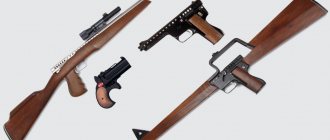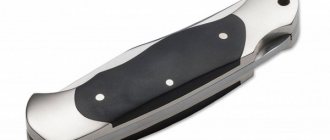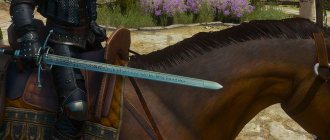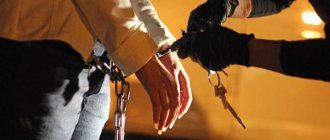Not to be confused with 45 mm and 4.5 mm calibers
| .45 ACP | |
| The .45 Auto cartridge is a modern Czech issue. | |
| Chuck type | pistol |
| Manufacturer country | USA |
| Type of weapon using cartridge | pistols, submachine guns, hard drives |
| Production history | |
| Constructor | Browning, John Moses |
| Time of creation | 1904 |
| Years of production | since 1905 |
| Characteristics | |
| Chuck length, mm | 32.4 |
| Real bullet caliber, mm | 11,51 |
| Bullet weight, g | 14,9 |
| Powder charge mass, g | 0,34—0,37 |
| Initial bullet speed, m/s | 260 |
| Bullet energy | 503 |
| Test barrel length, mm | 127 |
| Sleeve parameters | |
| Sleeve length, mm | 22,81 |
| Case neck diameter, mm | 12.0 |
| Case neck diameter, mm | 12,01 |
| Sleeve base diameter, mm | 12,09 |
| Sleeve flange diameter, mm | 12,19 |
| Media files on Wikimedia Commons | |
.45 ACP
and
.45 Auto
, where
ACP
is from English.
A
utomatic
Colt
P
istol ,
.45
caliber - Colt automatic pistol of 0.45 inch caliber (sometimes in the European manner designated as 11.43 mm or 11.43 × 23 mm) - American pistol unitary cartridge with a cylindrical wafer-shaped sleeve, developed in 1904. Adopted by the US Army in 1911 along with the adoption of the M1911 pistol. It was the main US army pistol cartridge during both world wars and after, until Operation Desert Storm. Since its inception, it has been a popular cartridge in the civilian market: both for self-defense (especially in the USA) and for sport. Based on the old .45 Schofield revolver cartridge, but with the flange diameter of a standard rifle cartridge.
Acquaintance
Today there are several standards for measuring the caliber of weapons. In this regard, often, when comparing a 45 caliber with a 16, the first may turn out to be smaller. In European countries and Russia, the metric scheme in millimeters is used for measurement. Calculate using the diameter of the trunk. Therefore, in rifled weapons, taking into account the depth of the rifling, the cartridge is slightly larger than in smooth-bore weapons. In Britain and the United States, fractions of an inch are used as a unit of measurement: in the USA, hundredths, in England - thousandths. For this reason, the American .45 caliber is listed as .450 in the UK. In Russia it is 11.43rd.
Weapons and abilities
The support fighter usually has a machine gun as his main weapon. Compared to representatives of other roles, these operatives carry more ammunition. Like all characters, the support fighter also carries a pistol and special equipment.
An operative's set of weapons in Caliber is always the same. That is, it cannot be replaced with another one, but it can be improved by upgrading by installing additional modules and improving characteristics.
In addition to serious weapons, the support fighter has a lot of health and armor. You have to pay for such luggage with speed. These operatives are heavy and move slowly. Even using the dash can't get them any closer to being particularly good at sprinting.
Below we talk in a little more detail about the variety of skills of support fighters using the example of operatives available in the game at the time of publication of the article.
Characters in Caliber are divided into three difficulty levels. This stat reflects how much effort the player must put into making the most of an operative's capabilities. You may have your own impressions of playing for each fighter, different from the classification we propose, and they are of key importance.
Difficulty I
Difficulty II
Difficulty III
The Recruits support fighter, Almaz and Sputnik are quite independent operatives. Their tactical capabilities are well revealed even without the involvement of other players. Therefore, we call them operatives of the first level of complexity. It is important to remember here that the success of the mission depends on the entire team. Therefore, even when playing as a first-level operative, do not forget to coordinate your actions with your allies.
Recruits support fighter
“Slowing Shot” ability - hits from the main weapon temporarily slow down the movement speed of wounded enemies. As a special weapon he carries an RDG-M smoke grenade. Restricted visibility and slowdown spoil enemy plans, and give the support fighter and allies an advantage*.
Almaz (Vympel, Russia)
Ability "Barrier". For the duration of its effect, Diamond receives a “Shield”, which absorbs damage until its strength is exhausted.
Almaz’s special weapon is a GM-94 multi-charge grenade launcher with smoke shots.
Also, from the second level of pumping, Diamond can revive a seriously wounded ally when he himself is incapacitated.
Sputnik (SSO, Russia)
The main ability allows the Companion to highlight enemy targets for itself and allies using a reconnaissance drone.
His special equipment is RPO-A. Flamethrower shots can eliminate several targets at once. From level 7, targets wounded by an explosion receive the “Weakness” effect and lose stamina points for some time.
Svarog, Keith, Bourbon and Bishop are operatives of the second level of complexity, since some calculation is required to make the most of their capabilities.
Svarog (“Alpha”, Russia)
Ability "Suppression". While it is in effect, opponents who have received several wounds from Svarog’s main weapon cannot enter aiming mode. At the last level of pumping, when using the ability, all Svarog’s allies increase the reload speed of their main weapon.
The GM-94 special weapon is a rapid-fire grenade launcher with fragmentation shots. To eliminate the enemy with one hit, Svarog will have to aim accurately. But from the 8th level of upgrade, all opponents, even slightly affected by the explosion of a shell, receive a concussion - they are slowed down and cannot use the dash.
As Svarog develops, he gains a special feature: for resuscitating an ally, he receives a bonus to stamina.
Kit (22 SPN, Russia)
Ability "Standard". Keith plants a flag, in the area of which allies' stamina points are replenished. The operative himself under the ability receives a “Shield” that absorbs damage. Also, one flag can revive one incapacitated ally or Keith himself.
The special weapon is the OZM-72 jumping mine. All enemies wounded by its explosion not only receive damage, but also cannot use the dash for a while. While leveling up, Keith gains immunity to the Stun effect while firing continuously.
Bourbon (SEAL, USA)
Ability "Daze". While it is active, several hits from the main weapon will stun and render the target unable to perform any actions. From level 11, eliminating an enemy while the “Daze” ability is active temporarily increases the movement speed of Bourbon’s allies, and after level 15, it also removes the negative effects “Slowdown” and “Stupor” from friends.
The special weapon is the M79 hand grenade launcher. After the 8th upgrade, you can install a delayed action fuse on it. This will allow you to “stick” the M79 shot to a surface or onto an enemy. The explosion will not occur immediately, but after 3 seconds. You can turn this improvement on or off by clicking on its icon in the leveling scale.
Bishop (Task Force Black)
Ability "Jammer". Bishop launches a device that interrupts the active skills of opponents and temporarily blocks the ability to use them again. If the enemy destroys the jammer installed by Bishop at full pumping, his entire team will be exposed. In development, Bishop can install two such devices on the map at once.
The special weapon is the L109A1 fragmentation grenade with maximum damage of 150 health points. The desperate Bishop keeps one such grenade in reserve for an enemy who dares to finish him off.
The L110A1 machine gun of the British support fighter also has a peculiarity - the longer continuous fire is conducted, the higher the rate of fire becomes.
We classify the Prophet and Stern as operatives of the third level of complexity, since in order to maximize their capabilities, they must correctly assess the situation and closely interact with their allies.
Prophet (GROM, Poland)
Ability "Forecaster". Activating it, the Prophet fires a 40mm smoke charge. While the ability is active, all enemies who are in smoke or under the influence of gas are illuminated. During this time, the Prophet takes 50% less damage if he is in smoke.
Special weapon - the HK69A1 grenade launcher with gas shots takes away 10 health points from enemies per second (when fully upgraded). The effect of the shot lasts 10 seconds. After the 8th upgrade, the Prophet himself becomes immune to the “Poison” effect.
Stern (KSK, Germany)
The Guardian ability allows Stern to use a Shield, which temporarily protects him from damage. A fighter can use the ability in two ways:
- apply “Shield” to an ally in front of you and receive a bonus for this in the form of an increase in the rate of fire of the main weapon;
- apply “Shield” to yourself and “pay” for this advantage by reducing the rate of fire of the main weapon.
At the last level of upgrade, the Shield becomes stronger, and the operative on whom it is applied becomes immune to Stun and Slow.
The special weapon is the RGW 90 grenade launcher. Having studied the 7th improvement, Stern can control the flight path of a projectile. After the 11th upgrade, shots deal full damage even to targets protected by cover.
Be sure to share your experience of playing as support fighters in a discussion on the forum or on Caliber’s pages on social networks.
About the characteristics
- 45 ACP is a type of pistol cartridge.
- Manufactured in the United States.
- The ammunition was created in 1904 and produced since 1905.
- The total length is 3.24 cm.
- The projectile weighs 15.16 g.
- The length of the sleeve is 22.81 mm, the diameter of its neck is 1.2 cm, the base is 12.09 mm, the flange is 12.19 mm.
- The ammunition is provided with a powder charge weighing from 0.34 to 0.37 g.
- A bullet fired from a barrel has an initial speed of no more than 271 m/s.
- During firing, an energy of 544 J is generated.
Russian artillery caliber
In Europe, the term artillery caliber
appeared in 1546, when Georg Hartmann[de] from Nuremberg developed a device called the Hartmann scale. It was a prismatic tetrahedral ruler. Units of measurement (inches) were marked on one face, and the actual dimensions (based on weight in pounds) of iron, lead and stone cores, respectively, were marked on the other three.
Examples (approximately):
- 1 face - mark of 1 lb lead core - corresponds to 1.5 inches;
- 2nd face - mark of an iron core weighing 1 pound - corresponds to 2.5 inches;
- The 3rd face - the mark of a stone core weighing 1 pound - corresponds to 3 inches.
Thus, knowing the size or weight of the projectile, it was possible to easily assemble, and most importantly, manufacture ammunition. A similar system existed in the world for about three hundred years.
In Russia, before Peter I, there were no uniform standards. The cannons and squeaks available in the army were each characterized separately by the weight of the projectile, in Russian national units. Pre-Petrine inventories mention guns from 1/8 hryvnia to a pood. At the beginning of the 18th century, on the instructions of Peter I, Feldmaster General Count Bruce developed a domestic caliber system based on the Hartmann scale. It divided the guns according to the artillery weight of the projectile (cast iron core). The unit of measurement was the artillery pound - a cast iron ball with a diameter of 2 inches and weighing 115 spools (about 490 grams). It did not matter what types of projectiles the gun fired - buckshot, bombs or anything else. Only the theoretical artillery weight that a gun could fire given its size was taken into account. Tables were also developed correlating artillery weight (caliber) with bore diameter. Artillery officers were required to operate with both calibers and diameters. In the “Naval Charter” (St. Petersburg, 1720), in chapter seven “On the artillery officer, or constapelle”, in paragraph 2 it is written: “You must measure the cannonballs to see if their diameters are similar to the calibers of the guns and place them on the ship according to your places." This system was introduced by royal decree in 1707 and lasted for more than a century and a half.
Examples:
- 3-pounder gun, 3-pounder gun - official names;
- artillery weight 3 pounds - the main characteristic of the gun;
- size 2.8 inches - bore diameter, an auxiliary characteristic of the gun.
In practice, it was a small cannon that fired cannonballs weighing about 1.5 kg and had a caliber (in our understanding) of about 71 mm.
Kozlovsky David Evstafievich in his book[4] gives a translation of Russian artillery weight[5] into metric calibers:
- 3 lbs - 76 mm,
- 4 lbs - 88 mm,
- 6 lbs - 96 mm,
- 12 lbs - 120 mm,
- 18 lbs - 137 mm,
- 24 lbs - 152 mm,
- 60 lbs - 195 mm.
Explosive shells (bombs) occupied a special place in this system. Their weight was measured in poods (1 pood - 40 trade pounds - equals approximately 16.38 kg). This is due to the fact that the bombs were hollow, with explosives inside, that is, made of materials of different densities. During their production, it was much more convenient to operate with generally accepted weight units.
Kozlovsky gives the following relationships:
- 1/4 pood - 120 mm,
- 1/2 pood - 152 mm,
- 1 pood - 196 mm,
- 2 pounds - 245 mm,
- 3 pounds - 273 mm,
- 5 poods - 333 mm.
A special weapon was intended for bombs - a bombard, or mortar. Its tactical and technical characteristics, combat missions and calibration system allow us to speak of a special type of artillery. In practice, small bombards often fired ordinary cannonballs, and then the same gun had different calibers - a general one of 12 pounds and a special one of 10 pounds.
The introduction of calibers, among other things, became a good material incentive for soldiers and officers. Thus, in the “Naval Charter”, printed in St. Petersburg in 1720, in the chapter “On rewarding” the amounts of reward payments for guns taken from the enemy are given:
- 30 pound - 300 rubles,
- 24 pound - 250 rubles,
- 18 pound - 210 rubles,
- 12 pound - 170 rubles,
- 8 pound - 130 rubles,
- 6 pound - 90 rubles,
- 4- or 3-pound - 50 rubles,
- 2 pound or less - 15 rubles.
In the second half of the 19th century, with the introduction of rifled artillery, the scale was adjusted due to changes in the characteristics of the projectile, but the principle remained the same.
About the advantages
According to experts, the 45 ACP cartridge has the following strengths:
- Ammunition projectile with very high stopping power. This indicator does not decrease even if a conventional jacketed bullet is used.
- Shooting a .45 caliber pistol involves heavy recoil. However, judging by numerous reviews, when using 45 ACP it is quite moderate. The owners appreciated the comfortable shooting with this ammunition.
- The cartridge provides high accuracy.
Weapons using the cartridge[ | ]
See also category: Weapons chambered for .45 ACP
- Ballester-Molina
- Colt Double Eagle
- FP-45 Liberator
- Glock 21
- HK UMP45
- HK HK45
- HK USP45
- Ingram MAC-10
- Ingram Model 6
- La France M16K
- M1911
- M1917
- Micro-Uzi
- Mini-Uzi
- Reising M50/M55
- KRISS Vector
- Thompson
- Uzi
- OTs-69
- SIG Sauer P220
- De Lisle carbine
- AF2011-A1 "Second Century"
About weaknesses
Despite the presence of undeniable advantages, 45 ACP is not without some disadvantages. The weaknesses of the cartridge include the following:
- High cost.
- Large weight and increased dimensions of ammunition.
- Due to the low initial speed and penetrating properties of 45 ACP, it has low destructive power.
- Bullets have a short firing range. With submachine guns you can hit a target from a distance of up to 70 m, with pistols - up to 30.
According to many experts, the demand for 45 ACPs is growing rapidly. This is due to the fact that new bullet variants have been developed for this cartridge. Judging by the reviews, expansive projectiles with controlled expansion are very popular among many shooters. Thus, having hit the body and penetrated to a certain depth, the bullet begins to unfold.
About weapon systems
Rifle units are assembled on the basis of two main schemes: pistol and revolver. Each of them has both strengths and weaknesses. Judging by reviews from owners, modern pistols provide automatic shooting and fast and easy reloading. Revolvers are highly reliable and the owner does not need to send ammunition down the barrel after firing. In addition, in revolvers, cartridge case extraction is not carried out automatically. On the one hand, this can be considered a disadvantage, since the shooter will then have to open the drum and remove the cartridge case himself. On the other hand, according to experts, this design feature increases the secrecy of use, which is used by special forces officers. Below are several models of 45 caliber weapons.
Ed Brown Executive Carry
This pistol is a custom Colt Commander, which, in turn, is based on the M1911. It was originally intended to be worn by officers, so it was smaller in size, but the Colt Commander lost the army competition. But the pistol became popular in the US civilian arms market, becoming a good alternative for those who wanted a military M1911, but were not satisfied with the size of the weapon.
Photo: edbrown.com
The Executive Carry is a variant of the Commander 1911, characterized by precise fitment, high quality and finishing of materials. Made of stainless steel, the gun has a matte finish and its sides are smoothed so as not to cling to clothing.
M1911
From 1911 to 1985, the Colt 45 caliber was in service with the United States. In the technical documentation it is listed as M1911.
Due to the high stopping power of the bullet, this semi-automatic rifle was recognized as the best model of weapon for self-defense. The Colt M1911 was produced until 1982. During this time period, the pistol was modernized several times. Despite the fact that the M1911 was retired from service by the US Army in 1985, many private owners still use it today. From 1911 to 1982 The United States gun industry produced three million units of this model. In addition, the M1911 was widely used by British, Soviet, Norwegian and French soldiers. The M1911 was also in service in Nicaragua and El Salvador. Estonia and Haiti have become those states where the 45-caliber Colt is used by the armies today.
Colt 1873
In 1872, the armory produced a rifle unit designed according to the revolver design. This model was fired with a unitary pistol cartridge.
In 1873, the 45 caliber revolver entered service with the United States. During the two decades that the American Army used this model, the US Armed Forces purchased more than 37 thousand rifle units. The revolver was produced in two versions: for the needs of the army, a 45 caliber was provided, and for civilian users, a 44 caliber. Since the 1890s, the production of revolvers has been suspended. Production was resumed only in the early 1950s. According to experts, the impetus for increasing consumer demand for the Colt 1873 was the popularization of Westerns by the American film industry.
As a result, revolver production was resumed in 1956, and it continues to this day.
Springfield Armory XD45 Mod 2 Service Model
The HS Produkt HS2000 pistol, developed in Croatia, attracted the attention of the American arms company Springfield Armory. In the American interpretation, the weapon received the designation (X-treme Duty). The idea to produce this pistol under license turned out to be so successful that within several years the XD model became one of the most popular in the US civilian weapons market.
Photo: springfield-armory.com
The pistol is available in several calibers: 9 mm, .40 Smith & Wesson and .45 ACP. In the American version, much attention is paid to the ease of holding and individual adjustment of the pistol to its owner.
A large notch on the handle, occupying a large area, allows you to hold the weapon stably during high-speed shooting. The barrel of the pistol is made with special care, thanks to which the weapon has the highest shooting accuracy in its class.
The XD45 Mod 2's double-stack magazine holds 13 rounds while maintaining a comfortable grip. By the way, the owner himself can customize the handle to suit his hand using three interchangeable elements. Source
MP 80 13T
In the line of various “trauma” weapons available on Russian arms counters, the non-combat rifle unit, which is listed in the technical documentation as MP 80 13T, is in great demand. The basis for this model was the legendary Makarov pistol. MP 80 13T is a 45 caliber “trauma”. Shooting is carried out with 45 Rubber cartridges. This shooting model, as many owners are convinced, is an excellent alternative to the 9-mm Makarych. Since the MP 80 13T uses ammunition with an increased caliber, Russian designers had to reduce the magazine capacity from 8 to 6 rounds. The ammunition is loaded with a 13-mm rubber bullet. During the shot, as the manufacturer assures, an energy of 90 J is generated. In fact, judging by numerous consumer reviews, this figure is slightly lower and varies from 70 to 80 J.
Unlike other “traumas” that use a smaller caliber, when firing from the MP 80 13T, due to the increased diameter of the projectile and the area of its contact, through holes are not formed. When hitting a target, 45 Rubber bullets leave only deep dents. For self-defense, this cartridge is considered the best option, since it will save the gun owner from problems with the law.
Version No. 3
0
Version No. 3 says that the 45 mm caliber is actually a 47 mm caliber, but: 1. It was developed according to a cunning plan so that the enemy could not use our shells if something happened. 2. 45 mm is exactly the same 47 mm, but was simply measured differently. Ours measured by the distance between the opposite fields of the rifling, and abroad they measured from the bottom of the rifling groove to the bottom of the opposite groove. Both cases are so-so. Finnish, World War II, and the Great Patriotic War showed that such an approach with calibers can and should be ignored and forgotten, since practice has shown that ammunition can usually be very easily provided with captured guns and vice versa. As for such aspects of measurement... You still can’t get such a difference, that’s why a lathe was needed in order to remove the copper bands and turn the projectile into a 45 mm one.








